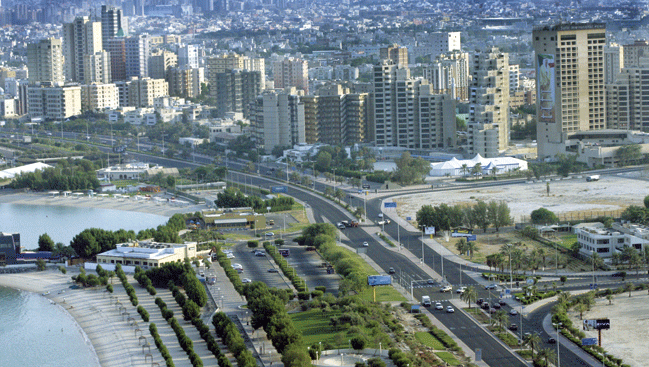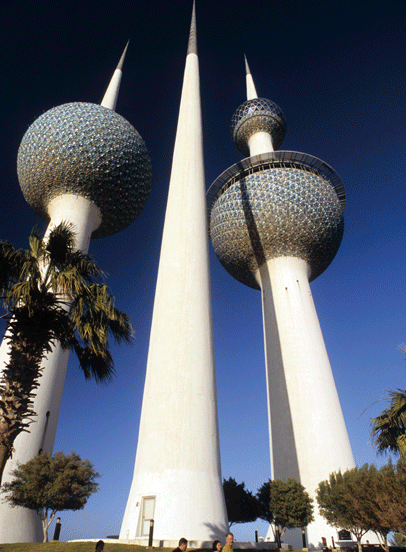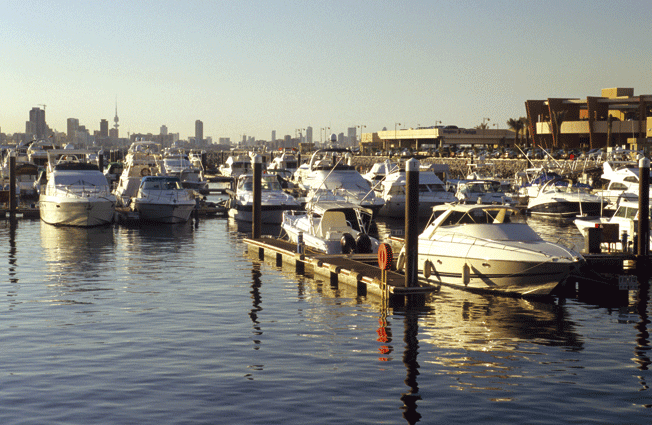
Travel
Kuwait Kaleidoscope

A transformation that has been wrought on the sands of the desert is perhaps the
best way to describe Kuwait's prosperity and rapid change over the past thirty years.
Today's visitor's first impression is undoubtedly of the effect of oil revenues on industry, commerce and urban growth.
By: Veronica Maria Garbutt
There is a vibrant growing interest and development of the arts and culture. Old souks have been replaced by modern malls and lush landscaped gardens abound. New mosques have sprung up everywhere too.
Kuwait lies in the northwest of the Arabian Gulf bounded by Saudi Arabia, Iraq and the sea. Major towns are Kuwait City, Ahmadi, centre of the oil industry, Fahateel and the historic town of Al Jahra. Industrial zones can be found at Mina Abdullah and Shuaiba, while Shuwaikh near Kuwait City includes the port. Currently the main exports are oil products, pipes, building materials, chemicals and shrimps.
Kuwait's history goes back to the Bronze Age when Failaka Island was inhabited. Later during the second century BCE a Greek Colony was established there. Owing to good natural harbours and a freshwater supply Kuwait became a bustling port and entrepot for merchants sailing up and down the Gulf. And like Bahrain, it developed a thriving pearling industry. 
Although theoretically under Ottoman sovereignty from the 16th century, day-to-day affairs were run by local tribespeople. In 1756 Sabah I was elected as the Sheikh of Kuwait and since then the Al-Sabah family has been ruling the country. In 1899 Kuwait became a British protectorate under the rule of Sheikh Mubarak al Sabah, known as Mubarak the Great. In 1938 oil was struck and in 1946 the first shipment of crude oil was exported. As the oil revenues began to flow the Kuwaiti standard of living improved dramatically. In 1961 the country became fully independent. Then Iraq invaded and occupied Kuwait in 1990 until liberation by an international coalition in 1991. Kuwait has since rebuilt herself, moving confidently into the 21st century.
Kuwait International Airport lies 10 miles south of the city. Take a taxi (identified by red licence plates) to get downtown. The rate is a fixed KD5. Located on the southern tip of an inlet off the Gulf, the city is easy to negotiate. Helpfully, street signs are in English and Arabic. Much of the commercial action is in Kuwait City but several new centres have sprung up in places like Salmiya and Marina Mall.
Downtown Arabian Gulf Street is the main coastal route, bordering Kuwait City on its seabord and sweeping southwards along the eastern side of the peninsula. Along its corniche-style length many of the country's main organisations can be found. These include the impressive National Assembly Building, the Great Mosque, National Museum and Seif Palace (Office of the Emir).
Fahed Al Salim is the city centre's main shopping street. Most of the fashion, textiles and household goods shops and plazas can be found around Al Jahra Gate. The souk specialises in gold necklaces, bracelets, Bedouin style brooches, coffee pots and hubble bubbles. Sadu House on Arabian Gulf Street is the best place to buy woven goods directly from the crafts people at work there. Popular items include rugs, tunics and reed baskets.
Beyond the souk Kuwait's many malls are the principal shopping areas. Salmiya complex near the Meridien Hotel is one of the most exclusive but newer centres such as Sharq Mall and Marina Mall are giving it plenty of competition. Indeed the dozens of airconditioned malls with their restaurants, cafes, cinemas and skating rinks are popular with entire families out for an afternoon or evenings shopping and entertainment. 
Time now to tour the highlights of Kuwait. Just off Arabian Gulf Street not far from the Municipal Park lies the National Museum. It was formerly home to one of the worlds most important collections of Islamic art, but was looted during the occupation. Today a series of galleries at the far end of the courtyard house artefacts from the Greek period on Failaka plus exhibits of seafaring, pearling, Islamic manuscripts from the 17th century, paintings and sculpture by Kuwaiti artists.
Next is the Great Mosque near Seif Palace on the corner of Mubarak al Kabir Street. This massive domed building is a fine example of modern Islamic architecture. It has a capacity of 5,500 with a central dome some 26 metres wide and 43 metres high. Further down the street is Kuwait Stock Exchange which is well worth a visit too. It is the Gulf's largest and trading takes place Saturday to Wednesday from 09.30 to 12.00.
Kuwait Towers are impossible to miss as they are the city's chief landmark. The highest is 187 metres and has two domes, one containing a café and restaurant with stunning views and the other used to hold water. The smallest tower controls the floodlights which illuminate the others. Also on site is the Ofok Restaurant which offers a breakfast buffet from 08.00-10.00 for ladies only, except on Fridays and public holidays when a family breakfast is served.
Over in the Jabrieh district lies the Tariq Rajab Museum, one of the Middle East's finest collections, located in the basement of a private house near the new English school. Although the focus here is on Islamic Art you will also find Omani and Yemeni daggers, antique clothes and jewellery, ceramics and pottery as well as talismanic garments printed with verses and prayers from the Quran from 18th century India.
Back in town on Abdullah al-Mubarak street lies the Science and Natural History Museum while along Arabian Gulf Street near Sharq you'll find a large complex of gardens, pathways, playgrounds and volleyball courts. The Maritime Museum beside a giant baglah sailing ship is well worth a visit. It lies several kilometres south of the centre at Salwa, adjacent to the Radisson SAS Hotel Kuwait. This is a stretch of beach with some well equipped hotel resorts including Messilah Beach, The Hilton Kuwait Resort and The Palms.
There are nine islands off the coast of Kuwait, but it is Failaka (pronounced Failacha in the local dialect) which is considered the most beautiful. Known as Ikaros ruling the Hellenistic period, it was also the first site in Kuwait to draw archeologists whose work in 1958 is described in Geoffrey Bibby's book ‘Looking for Dilmun'. Every weekend the Bint al Khair hydrofoil departs from the jetty of Marina Mall for the 30 minute crossing to Failaka.A tour of the island on a former London double decker bus takes in the archeological site, a camel farm and a military museum teeming with Iraqi hardware. The remainder of the day is spent at the Tourist Complex with lunch of delicious mezze and time out visiting a Bedouin tent, attar perfumery and crafts village where potters, weavers and metal beaters are at work. Tea can be taken at the Ikaros Hotel or, if you fancy you can have a whiz around the island by quad bike or bicycle. 
Dining out in Kuwait is fun with cafes and restaurants to suit every budget. Be sure to try Machbous, a traditional, spiced rice, nut and meat dish with unleavened Arabic bread at Um Habib Traditional Kuwaiti Restaurant. At Al Nouhkhaza Seafood Restaurant you can chose your fish from a giant display set amid nets and nautical paraphernalia. Hammour (grouper) from the Gulf is my recommendation. And over at Al Boon (The Dhow) Steak and Seafood Restaurant you can sample giant succulent Gulf shrimps right beside the sea.
For French cuisine try La Brasserie while if it is Japanese sushi you hanker for head for the peaceful Sakura. Mughal Mahal is perhaps the best patronised Indian restaurant in Kuwait, while Riccardo's does excellent Italian dishes. Before leaving the emirate be sure to sample cardamom flavoured Arabic coffee and sheesha water pipes in the garden on Beit Lothan, a traditional coffeehouse. The fresh dates too here are sweet and succulent … a not to be missed experience.
The local currency is the Kuwaiti Dinar (KD) divided into 1000 fils. The national flag is a rectangle divided into three horizontal stripes of green, white and red (top to bottom). A black trapezoid is set into the stripes on the pole side. Kuwait's summers are always hot … the temperature can even reach the high 40s °C. But remember you can always go skating at the ice rink! Winters are generally pleasant by day but can be cold at night. Best time to visit is from mid-October to mid-March but be sure to pack a medium-weight jacket plus a sweater. Ahlan Wasahlam (Welcome!).